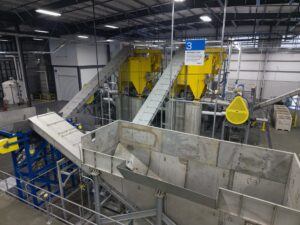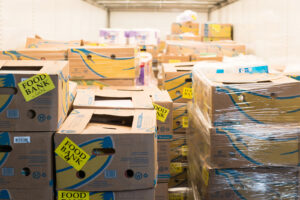January 6, 2025
In this blog: Economics of Food Waste | Supply Chain Impacts | Inflation & Food Insecurity | A Circular Economy Approach | Benefits of Reducing Wasted Food | Policies on Wasted Food | Your Partner in Reducing Wasted Food
Summary: Wasted food comes at a high price to individuals and industries, with a global estimated economic impact of $940B annually. This blog post explores the economic consequences of wasted food, and what businesses can do to reduce wasted food at scale.
Wasted food is a social and environmental problem, but it is also an economic problem that impacts individuals and industries around the world. In this post, we’ll unpack the economic consequences of wasted food and how businesses can adopt a circular approach to managing their unsold food, to achieve operational efficiencies and cost savings.
The Economic Impacts of Food Waste
A 2024 report from the U.N. estimates that around a third of all food goes to waste globally each year –– over one billion tons –– which amounts to nearly $940 billion in economic losses annually.
In the U.S., nearly 40% of food (63 billion tons) is lost or wasted annually, costing an estimated $218 billion – roughly 1.3% of the country’s GDP. This year, the Biden Administration set a goal to reduce wasted food by 50% by 2030, which could save an estimated $120 – $300B per year.
According to ReFED, in 2019 lost and wasted food cost the food industry $250 billion, with restaurants and other food service businesses shouldering the greatest financial burden.
How Food Waste Impacts the Supply Chain
Food waste leads to significant financial losses along the entire supply chain, from the fields to the grocery store shelves.
Farming accounts for 16.8% of wasted food, where environmental and market conditions, such as imperfections, pricing, and labor shortages can impact what gets harvested and sold. When farm produce doesn’t get sold or eaten, the resources used to grow it go to waste, such as water. ReFED estimates that unsold and uneaten food accounts for 14% of all fresh water use and 18% of cropland use. Farmers bear the burden of these wasted resources, paying up front for the water, soil amendments, fuel, and labor, only to face serious financial losses when their goods aren’t purchased.
Downstream in the supply chain, wasted food is often a result of human and technological error, allergen cross-contamination issues, manufacturing experimentation for quality and quantity of new products, and inefficient inventory management. Consumer behavior, from buying trends to aesthetic expectations to understanding of food date labeling, also impacts waste volumes for consumer-facing businesses, such as retail environments and restaurants.
Wasted food is a cost that many businesses pay twice: first to supply their operations, and again when paying to dispose of it. To accommodate the increased costs of doing business and remain profitable, these businesses often increase the price of their food for consumers.
Food Waste’s Impact on Inflation – and Food Security
Food waste drives up food prices, contributing to inflation, in two main ways:
- Wasted food strains natural resources needed to grow more food, which leads producers and manufacturers to increase prices.
- Inefficiencies within the food system that lead to wasted food can cause producers and manufacturers to increase their prices to accommodate the lost revenue.
These factors ultimately increase the cost of food available to everyone, the impact of which is felt most acutely by those who are low-income and food insecure.
Meanwhile, edible food that could be donated is often sent to the landfill, which also decreases access for low-income communities. According to an EPA report from 2021, the amount of wasted food “is sufficient to feed 154 million people per year, a far greater number than estimated by the USDA to be food insecure.”
It’s clear from these statistics that our current food system isn’t sustainable for consumers or businesses. We need to transform the way we manage food so that we can prevent waste, lower costs, and make food more accessible for everyone.
Making the Food Value Chain Circular
A circular approach to managing unsold food can help our food system adapt to reduce waste and increase access and affordability while protecting the resources needed to continue growing food for future generations.
There are a few important steps businesses can take to adopt a circular approach:
Prevention with data + technology: Businesses can’t manage what they don’t measure. What are the root causes behind the food that doesn’t get sold and eaten? Was the food blemished, or thrown away by mistake? Was a menu item less popular than expected? Did a customer cancel an order for pallets of a product? Technology like Divert’s RFID tracking system can help businesses uncover meaningful data and contextualize it to inform their inventory decisions, discount programs, and optimize donations to prevent waste.
Optimizing food recovery: The food industry’s biggest responsibility is to make sure edible food reaches the people who need it most. Waste audits and co-training programs like Divert’s can help businesses like retail grocers and food service operators identify opportunities for optimizing their food recovery programs so that their edible, unsold food reaches those in need.
Recycling non-donatable, inedible food: Even when food can’t be sold or donated, it is still a valuable resource. Through recycling processes like anaerobic digestion and composting, the valuable nutrients and water embedded in the food material can be rescued and reused for beneficial byproducts like renewable energy and soil amendments. These byproducts can be applied directly to the farms where the food is grown to create a closed-loop system, as Divert has done with a sustainable farm in Pacific Northwest, or the byproducts can be applied to nearby farms and communities.
Anaerobic digestion technology is an ideal solution for commercial businesses because it can handle the high moisture content from large volumes of organic material, filter it for microplastics, and convert it into renewable natural gas for the local power infrastructure, offsetting the need for petroleum-derived natural gas.
The Economic Benefits of Reducing Food Waste
A circular food system can not only mitigate the social and environmental harm of wasted food, but it can also mitigate the economic losses of wasted food and give businesses new opportunities for operational efficiencies and cost savings, while fulfilling their ESG commitments.
Reducing food and vegetable waste alone represents an $18 billion opportunity for retailers, while waste tracking efforts could unlock a $3 billion opportunity for the food service industry.
On a national level, ReFED has estimated that a $14 billion investment in food waste reduction solutions each year for the next ten years, the U.S. can achieve:
- Reduce wasted food by 45M tons annually
- Deliver $73 billion in annual net financial benefit for the country
- Reduce GHG emissions by 75 million metric tons and rescue food equivalent to four billion meals for people in need each year
- Create 51,000 jobs over ten years
- And achieve the 2030 reduction goal of reducing national wasted food volumes by 50%.
Global, National, and State-Level Policies to Reduce Wasted Food
Another thing for businesses to consider is compliance with emerging food waste legislation.
More than 3,000 publicly traded companies are subject to climate disclosures by the Securities & Exchange Commission, while more than 10,000 companies are subject to climate regulations in the state of California, which is leading the way on emerging legislation for organic waste management. These federal and state standards not only establish regulations to ensure that businesses are required to change how they manage their wasted food, but in some cases, they also open new opportunities for businesses to collaborate with different types of organic waste programs than they were previously able to.
In June 2024 the Biden-Harris Administration announced a federal interagency collaboration and national strategy for reducing food loss and waste, with the goal of halving wasted food by 2030. With the potential for federal policies to change in 2025, state and local policies present the most possibility for progress. Tools like Divert’s Food Waste Legislative Tracker provide details on active legislation across all 50 states so that stakeholders can prepare their operations for new regulations and get involved in shaping actionable policies, alongside organizations like the Zero Food Waste Coalition.
The Circular Solution for Managing Unsold Food
At Divert, we believe sustainability can be as good for business as it is for the environment. We also believe that unsold food is a valuable resource and when we treat it that way, it opens up new economic opportunities to make our food system more efficient and sustainable for the long-haul.
Through our holistic approach, we’ve helped our customers manage their unsold food responsibly to achieve operational efficiencies and reduce trash costs, strengthen their food recovery efforts, and transform non-donatable food into carbon-negative renewable natural gas. We’re the circular solution to solving the wasted food crisis.
Learn More
See how Divert’s solutions are creating a circular food economy.



